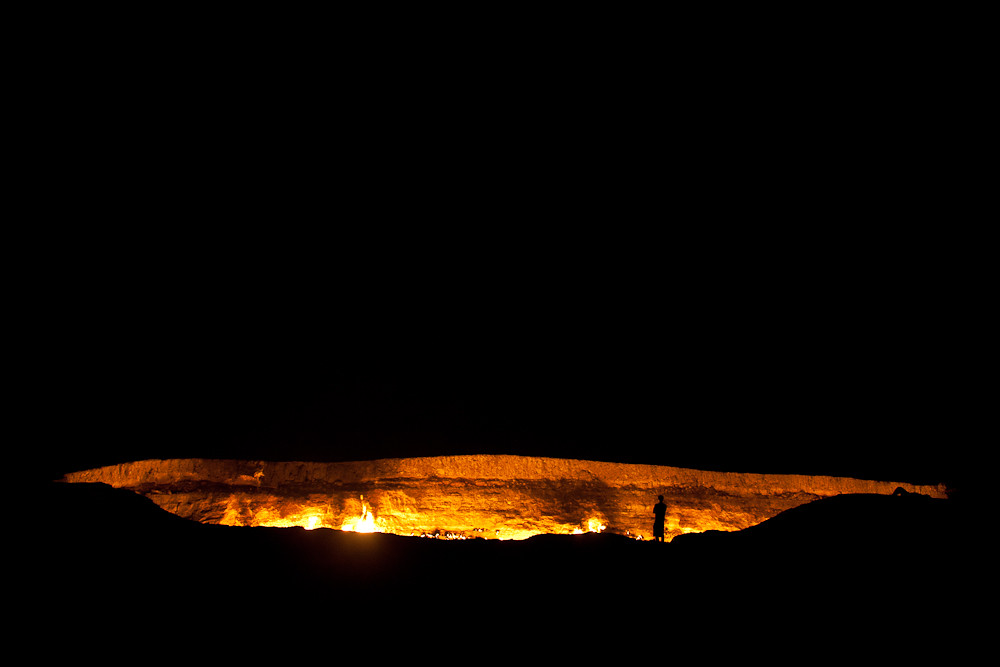The Darvaza gas crater, often called ‘The Door to Hell,’ is a mesmerizing geological wonder in Turkmenistan’s Karakum Desert. Ignited accidentally in 1971, this crater has been burning ever since, turning a natural gas leak into a perpetual fire that attracts countless visitors each year. The incident happened during an oil exploration attempt, creating this dramatic inferno. Its ongoing combustion for over four decades raises fascinating questions about gas extraction processes and the stability of underground reservoirs, making it a subject of both scientific study and tourist interest.

The eternal flames of the Darvaza Gas Crater began with a mistake.
The tale begins in the Soviet era with geologists searching for oil fields in this barren landscape. Their drilling led to a disaster when they accidentally tapped into a natural gas cavern, causing the ground to collapse. This mishap resulted in several open craters, the largest being about 230 feet wide and 65 feet deep. Luckily, no one was hurt, but the uncontrolled release of natural gas posed a significant challenge. Natural gas, mainly methane, is non-toxic but displaces oxygen, creating a suffocating environment for local wildlife. To address this, scientists decided to ignite the gas, expecting it to burn out in a few weeks. This practice, known as flaring, is common in oil and gas operations to manage excess gas. However, the Darvaza situation was unique. The scientists underestimated the gas volume, and what was meant to be a temporary solution turned into an eternal flame.
As the years rolled on, the desert became home to a glowing spectacle, with flames reaching heights that could be seen from miles away. The crater has continued to burn, creating a surreal desert landscape and drawing the curiosity of locals and travelers alike. The natural beauty of the surrounding Karakum Desert contrasts starkly with the fiery chaos of the crater, making it a unique destination for adventure seekers. Visitors often describe their awe when witnessing the flames at night, as the darkness amplifies the glow and the heat radiates across the landscape.
The impact of the Darvaza gas crater demonstrated a fascinating interplay between nature, society and human intervention.
Exploring the Darvaza gas crater’s impact reveals a complex interplay between nature, society, and human intervention. As the flames continue to flicker in the Karakum Desert, they cast not just light but also shadows over the environment and local communities. The crater is an ecological paradox: it draws tourists and scientists while posing significant environmental challenges. The flames are not just a spectacular sight but a symbol of the ongoing struggle between human activity and the natural world.
The natural gas burning at the Darvaza site primarily consists of methane, a potent greenhouse gas that, when released into the atmosphere, contributes significantly to climate change. Methane is estimated to be over twenty times more effective at trapping heat in the atmosphere than carbon dioxide over a short time frame. While the fire provides a temporary solution to a catastrophic gas leak, it also exemplifies the complex relationship between energy production and environmental degradation. The flames, mesmerizing as they may be, serve as a stark reminder of the environmental cost of energy extraction and consumption.
Moreover, the Darvaza crater has ecological consequences that extend beyond simply emitting greenhouse gases. The attraction of local wildlife, notably desert spiders, to the flames presents a bizarre twist to the story. These creatures, drawn to the light, are often seen tumbling into the inferno, highlighting the unintended consequences of human error. This interplay between fire and fauna raises questions about the impact of such phenomena on local ecosystems. As wildlife is inadvertently lured to a fiery demise, it underscores the fragility and interconnectedness of desert life.
Beyond its ecological impact, the Darvaza gas crater holds significant cultural and social importance. It has turned the surrounding area into an unexpected tourist attraction. Thousands of visitors come each year to witness the spectacle, boosting the local economy. The flames attract adventurers and curious travelers, eager to see the burning crater under the night sky. For many, it becomes a journey of discovery, blending scientific curiosity with the thrill of exploration.
However, the influx of tourists also brings challenges. The infrastructure to support this interest is limited, and as more visitors come, the environmental impact increases. Issues like trash, noise, and potential damage to the fragile desert landscape need to be addressed. While tourism can bring economic benefits, it also requires careful management to preserve the natural environment for future generations.
Interestingly, the presence of the crater has sparked discussions about energy policy and environmental responsibility in Turkmenistan. The government’s previous interest in extinguishing the fire reflects broader concerns regarding energy management and ecological sustainability. In recent years, as the world has faced increasing challenges related to climate change, the crater has become a focal point for dialogue about the need for responsible energy practices. Despite the initial decision to light the fire as a solution to the leaking gas, this ongoing blaze symbolizes the need for a reevaluation of how we interact with our planet’s resources.
As the fire continues to burn, it serves as a paradoxical symbol of both human ingenuity and folly. The Darvaza crater highlights the complexities of modern energy needs, prompting reflection on the sustainability of such practices. In a world where fossil fuels dominate energy discussions, the crater offers a chance to rethink our relationship with natural resources and the environment.
The tale of the Darvaza gas crater is far more than a simple story about a fire in the desert. It encompasses elements of scientific inquiry, ecological impact, cultural significance, and energy policy. As we delve deeper into its story, we find layers of meaning that challenge us to consider the implications of our actions on the environment. The flames remind us of the power of nature, the consequences of human activity, and the urgent need for sustainability. In witnessing the eternal flame, we are confronted with questions about our energy future, our ecological footprint, and the nature of our responsibility as stewards of the Earth.

The Darvaza gas crater symbolizes the tension between human ambition and environmental stewardship. It urges us to reflect on past actions, recognize current realities, and commit to sustainable practices for the future. The persistent flames in the Karakum Desert captivate our imagination and emphasize the need to live in harmony with nature. As we explore the reasons for its unextinguished fire, we are reminded of the critical implications of our energy choices in an evolving world. Ultimately, the crater calls for action from future generations, highlighting that today’s decisions will shape tomorrow’s landscape.
Related posts:
This Hellish Desert Pit Has Been On Fire for More Than 50 Years
Eternal flame
Why is there a fire in Turkmenistan that never goes out?





